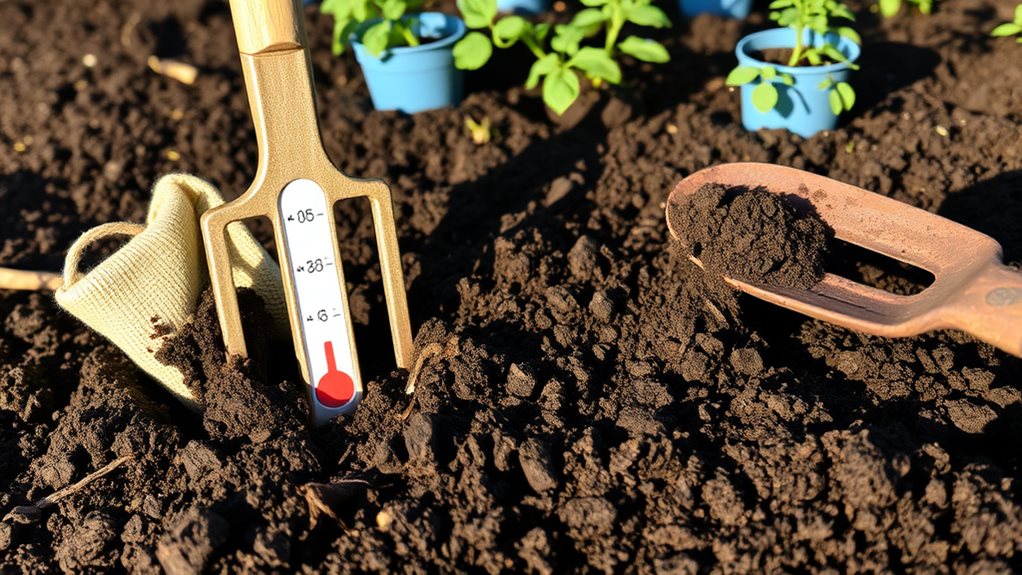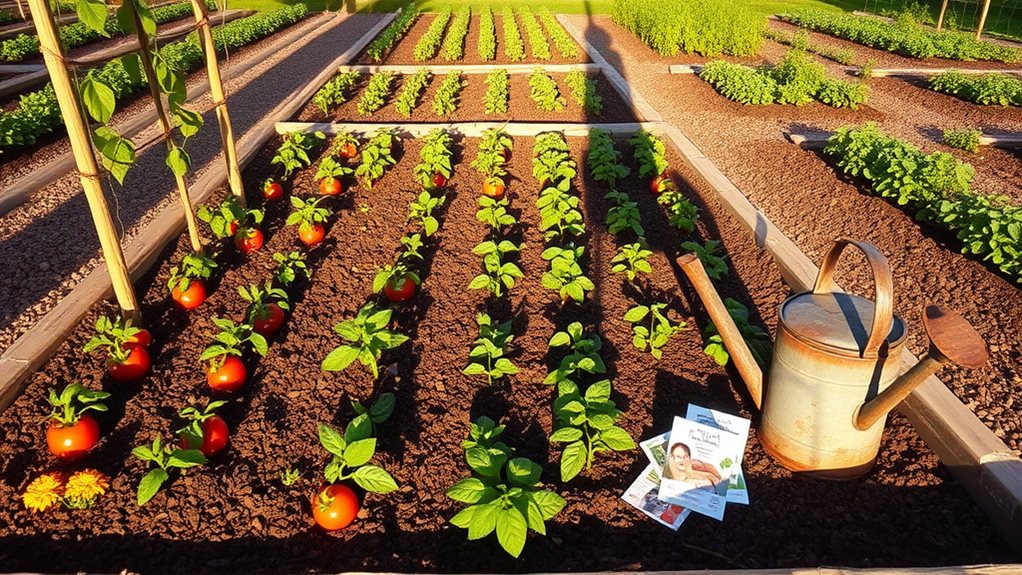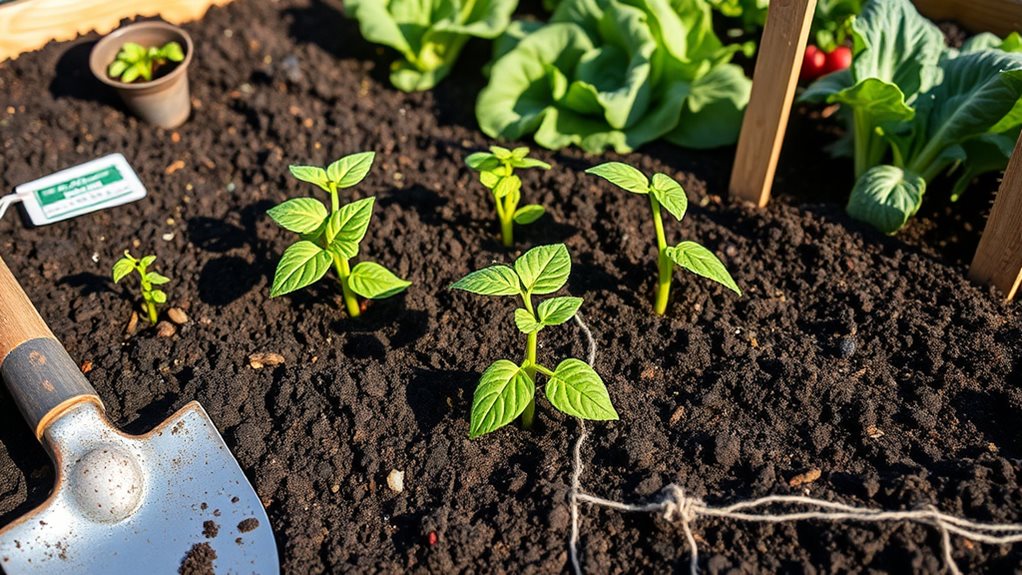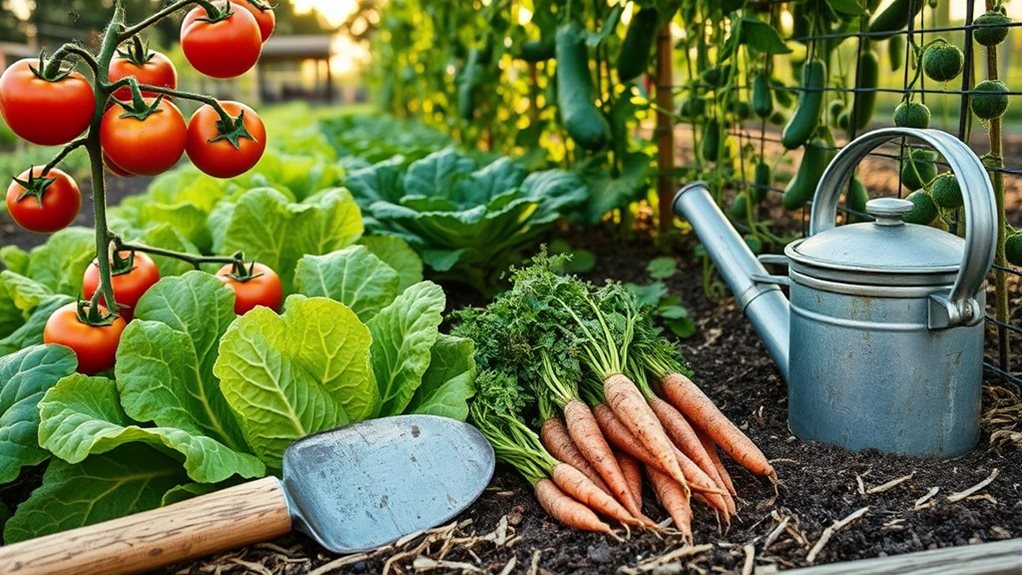Where to dig in?
How to make garden at home?
Choose a south-facing site with at least six hours of direct sunlight, on level or gently sloped ground, avoiding low spots prone to standing water. Guarantee easy access and proximity to water, away from trees and heavy foot traffic. Clear debris, test soil pH and nutrients, then enrich it with compost or manure while loosening to 8-12 inches depth. Select vegetables suited to your climate and seed instructions for spacing. Water regularly and mulch to conserve moisture. More details can guide your planting success.
Selecting the Perfect Spot for Your Vegetable Garden

Where you place your vegetable garden can make all the difference between a bountiful harvest and disappointing results. Most vegetables need at least six hours of direct sunlight daily, with eight to ten hours being ideal for the best growth.
Choose a south-facing location if possible, as this provides prime sunlight exposure. Avoid low-lying areas where water collects, since plant roots need oxygen to thrive. Your garden should be on level ground or a gentle slope for proper drainage.
Select a spot that’s easily accessible for maintenance and close to a water source. Many productive vegetables like tomatoes, corn, and peppers require full sun exposure to develop properly and resist disease. Stay away from old house perimeters which may contain lead contamination from old paint. Test your soil before planting to confirm it’s free from contaminants and has the proper pH level for vegetable growth. Having the right garden tools on hand, such as trowels and watering cans, will make maintaining your vegetable garden much easier.
Essential Tools and Supplies for Beginner Gardeners

To commence on your vegetable gardening journey, you’ll need the right tools that make planting, maintaining, and harvesting your crops much easier and more enjoyable. Start with these basic items that won’t overwhelm your budget but will provide everything necessary for success. Consider investing in a soil test kit to determine the nutrient levels and pH of your soil for optimal vegetable growth. Understanding your soil composition will help you determine whether you have sandy, silty, loamy, or peat soil, each supporting different types of vegetables.
| Tool Category | Essential Items | Purpose |
|---|---|---|
| Hand Tools | Gloves, Pruning Shears | Protection and trimming |
| Digging Tools | Garden Fork, Spade | Turning soil, digging |
| Weeding Tools | Hoe, Garden Rake | Removing weeds, leveling |
| Watering | Watering Can/Hose | Plant irrigation |
| Supplies | Seeds, Compost, Labels | Growing, enriching, organizing |
Preparing Your Soil for Optimal Plant Growth

As you begin preparing your soil for vegetable gardening, it’s crucial to focus on creating a well-balanced and fertile environment that supports healthy plant growth. You should work with soil when it’s moist but not wet, as this makes it easier to handle, especially for clay soil. Loosen the soil to a depth of about 6-10 inches to accommodate vegetable roots. Additionally, maintaining an ideal soil pH, typically between 6.0 and 7.0, is essential for optimal nutrient availability and microbial activity, which can be achieved by adding amendments like lime or other modifiers as needed. To enrich the soil, aerobic decomposition of organic materials such as kitchen scraps and yard waste can create nutrient-rich compost.
Key steps for preparing your soil include:
- Removing Debris: Clear the area of any rocks, roots, or debris.
- Soil Testing: Conduct a soil test to determine pH and nutrient levels.
- Adding Organic Matter: Use compost or manure to improve soil structure and fertility.
- Clod Breaking: Break up large clods for uniform soil structure.
Choosing the Right Vegetables for Your Climate

Choosing the right vegetables for your climate is key to a successful garden. You must consider the temperature tolerance and hardiness zones of different vegetables. For example, broccoli and cabbage thrive in zones 5-10, while tomatoes require zones 7-10.
Cool-season crops like peas, lettuce, and spinach are ideal for early spring and fall. Remember that factors such as garden size and raised beds can impact vegetable selection and growing conditions.
To select suitable vegetables:
- Identify Your Zone: Use the USDA hardiness zone map to determine your zone.
- Choose Vegetables: Select vegetables based on their temperature tolerance and your zone.
- Consider Climate Challenges: Think about drought tolerance, frost sensitivity, and pest resistance.
Designing an Efficient Garden Layout

Designing an efficient garden layout is essential for maximizing space, optimizing plant growth, and enhancing the aesthetic appeal of your garden. It involves evaluating the site for sunlight, soil type, and drainage, then planning accordingly. Use permaculture principles to plant perennial vegetables and herbs well-suited to your site.
To enhance your garden design, consider these key elements:
- Row Planting: Plant in evenly spaced rows to optimize sunlight.
- Block Planting: Divide the garden into square blocks for companion planting.
- Raised Beds: Use raised beds to improve soil quality and visual balance.
- Vertical Gardening: Incorporate trellises to maximize space for climbing plants.
Beginners can benefit from easy-to-cultivate plants like tomatoes and lettuce, as they are ideal for those just starting out.
Planting and Growing Techniques for Success

Effectively starting a vegetable garden involves mastering several key techniques to guarantee healthy growth and plentiful harvests. You should test your soil’s pH levels and adjust them if necessary to safeguard optimal growing conditions. When planting, choose seeds suitable for your region and plant them at the right depth, typically two to three times deeper than their diameter. For efficient growth, provide at least six hours of sunlight daily, and water deeply but infrequently.
One promising method to enhance soil structure is no-till gardening, which helps maintain soil composition and microbial activity. Use organic fertilizers like compost to enhance soil fertility. Implement integrated pest management to protect your plants from pests and diseases. Regular pruning and training will also promote healthy growth. Ensure that your garden is located away from foot traffic for better maintenance and reduced damage.
Seasonal Maintenance and Harvesting Tips

Now that you’ve established a solid foundation for planting and growing your vegetables, it’s time to focus on seasonal maintenance and harvesting techniques. This involves adapting your methods to the changing seasons, guaranteeing ideal growth and yield.
- Debris Removal: Clear your garden of winter debris and dead leaves.
- Soil Testing: Conduct soil tests to check nutrient levels and pH.
- Cool-Season Planting: Plant cool-season crops like broccoli and spinach.
- Irrigation Setup: Maintain consistent watering with well-maintained irrigation systems. Composting can also play a role in seasonal care by improving soil quality through essential concepts such as the balance of green and brown materials.
Effective seasonal care also involves regular monitoring of your vegetable plants. This includes inspecting for pests and diseases, and performing tasks such as pruning to ensure optimal plant health, including removing dead or dying leaves to prevent pest and disease issues by applying techniques like mulching.
Frequently Asked Questions
How Long Does It Take for Vegetables to Mature?
The time it takes for vegetables to mature varies. Quick-maturing vegetables like radish, lettuce, beet, spinach, and turnip take 30-60 days. Moderate-maturing vegetables, such as cucumber, okra, carrot, pepper, and tomato, require about 60-80 days. Slow-maturing vegetables, including potato, cantaloupe, cauliflower, pumpkin, and eggplant, take over 80 days. Continuous producers like cucumbers and zucchini yield throughout the season.
Can I Grow Vegetables Indoors All Year?
You can grow vegetables indoors all year, benefiting from year-round harvesting. Choose plants like cool-tolerant greens or warm-season crops like tomatoes and peppers.
Guarantee adequate lighting, typically 10 hours a day, and maintain temperatures between 60°F and 70°F. Use tools like grow lights and high-quality potting soil to support growth.
This setup allows for continuous succession planting to keep your harvest fresh year-round.
What Vegetables Grow Well Together?
You can grow vegetables like corn, beans, and squash together effectively. Corn provides a trellis for beans, while squash shades the soil and suppresses weeds.
Cucumbers and spinach work well together, with cucumbers providing shade for spinach when trellised.
Tomatoes and basil pair nicely, as basil repels pests that target tomatoes. These combinations enhance growth and pest control.
How Do I Protect My Garden From Wildlife?
Protect your garden from wildlife by using sturdy fencing made of materials like wood, metal, or plastic. Bury the fence 6 to 8 inches deep to thwart diggers.
Choose a tall fence to deter jumpers like deer. You can also electrify your fence for added protection.
Remove attractants, plant repellent herbs, and use motion-activated devices to scare wildlife away. Consider using covered planters or raised beds for extra protection.
Regular monitoring is essential to address any damage early.
Are There Any Companion Plants for Vegetables?
You can enhance your vegetable garden with companion plants. Popular combinations include Tomatoes and Basil (pest control and yield improvement) and The Three Sisters (corn, beans, and squash for mutual support).
Marigolds deter nematodes, while Beans provide nitrogen for corn. Choose plants that offer benefits like pest control, space optimization, and improved soil health.
Conclusion
As you complete your vegetable garden, remember to stay engaged and observant. Keep your garden well-watered and fertilized, and harvest your vegetables as soon as they’re ready. With a well-planned garden layout, you’ll enjoy a continuous supply of fresh produce. Regular maintenance and seasonal adjustments will help you refine your techniques and optimize your garden’s performance over time.

